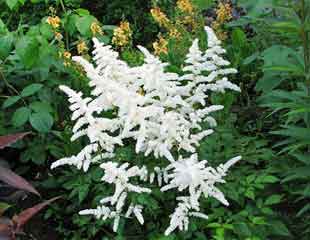
Astilbe 'Professor ven der wielen'

Astilbe 'Fanal'

The national collection Holehird Gardens
How to grow Astilbe
Astilbes are a group of plants which will tolerate semi shade and so are useful for those parts of the garden which do not have the benefit of much sun. Astilbes prefer damp or moist soil, and are suitable for waterside or semi bog planting as long as the ground is not waterlogged. Growing requirements for Astilbes are simple; a semi shaded place in soil which tends to be damp and does not dry out and in these conditions Astilbes are easy and unfussy plants. Astilbe are suitable for all soil types, including acid soils, the only exception is dry soil.
Astilbe will tolerate drier soil as long as it is still shady. Astilbe are tolerant of poor conditions and will grow in exposed areas. Astilbe are a herbaceous perennial which means they die back to bare earth over winter and re grow each spring.
Astilbes are grown for their lovely fluffy plume like panicles 18-35cms long which are either red, pink, purple or white. Astilbe range in size between, from the very small 8cm A.glaberrima var.saxatillis to the giant variety 2m A.chinensis var. davidii. Most however are between 15-25cms up to 80-130cms depending on the species and variety, and flower between late June and August. If you want an Astilbe for a specific part of the border, tall or medium, it's necessary to check the label for the plant description as Astilbes vary in size.
A benefit of growing Astilbe is that they are fully hardy and perennial, which means they do come back reliably each year to provide colour in the garden and are good value for money. If your Astilbe is looking less good, not flowering as well and it has been established for a few years, it is best to divide it which should improve it.
Astilbes are easy to grow and need little maintenance other than to be trimmed back in the early spring ready for the new growth and periodically divided.
When planting Astilbe they look good both as single plants, images above and growing in clumps. The foliage is attractive, feathered and delicate. It is easy easy to under rate Astilbe, a modest plant, but very attractive flowers and foliage. Best of all, Astilbe are adaptable and make good companion plants for many common garden plants, and look well with Hostas, ferns and grasses and look good combined with these plants alongside a stream or pond - see illustrated in planting ideas for damp shade which shows just how lovely this combination is along side a pond.
If you are interested in seeing Astilbes and on holiday in the Lake District in July, Holehird gardens houses the national collection, which is well worth a visit.
Companion plants which grow well with Astilbes
Astilbe grow well in shade and damp areas of the garden and so it follows the plants which grow well and make good companions to Astilbe will enjoy similar growing conditions. Astilbe are often grown in the margins of a pond where they mix well with ferns and grasses such as in the illustration below, Carex 'Golden Bowles'. Astilbe are also ideal to grow with Hosta which will need slug protection. Astilbe look well planted in a woodland garden but I have also seen Astilbe growing well in a mixed border, as the images show, providing it is not too hot or dry. This combination of dark red Astilbe in a mixed border was taken at Arley Hall. Like many plants a good clump of Astilbe look good on their own as shown in the soft pink plumes illustrated below.
Red Astilbe in mixed border

Red Astilbe planted in mixed border seen at Arley Hall.
Pink Astilbes grouped together

Here a large group of pink Astilbes have been planted together to good effect
Astilbe planted with grasses

Astilbe in mixed grasses planting combination including Carex 'Golden Bowles'
Astilbe planted by a pond

Astilbe look particularly good planted alongside a pond with grasses and ferns
Recommended varities of Astilbe
When selecting Astilbe for your garden those varieties which have the RHS award of garden merit are well worth looking at. Astilbe 'Fanal' (× arendsii) (image above centre) is a strong red colour with fluffy plumes growing up to .45m ; also with RHS award is A. 'Brautschleier' (× arendsii) a white variety, slightly taller .6m and Achinensis var. taquetii 'Superba' a delicate mauvy pink shade and taller at 1m. Astilbe are very hardy down to H7 under the new RHS frost hardy classification.
A very similar plant, which also tolerates shade and likes damp conditions is Aruncus. It is summer flowering, easy to grow, and looks very similar except it is a larger plant and only has white flowers. Aruncus is suitable if you are looking for the same effect, fluffy flower heads but on a larger scale. Astilbes tend to grow up to around 60cms compared with Aruncus which grow up to 1.5-2.5m The flowers are slightly different as the image below illustrates. In other respects it's growing requirements are very similar and will thrive in damp shade.
Key growing points for Astilbe
Easy to grow tolerant of most conditions
Astilbe prefer part shade and tolerate damp growing areas
Herbaceous perennial which will die back over winter
Pest Free

Aruncus which is very similar to Astilbe

